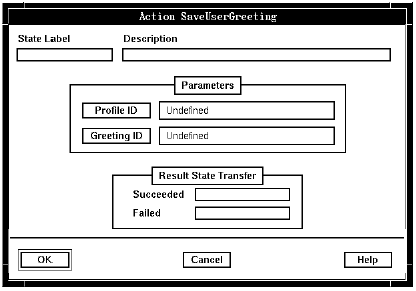Purpose
Use SaveUserGreeting to save the digitized voice data that speaks the greeting to a caller from temporary workspace to disk.

Description
When a user greeting is first recorded, it is saved in a temporary workspace so that it can be rerecorded if necessary. This action saves the greeting to disk.
When the user greeting is recorded, the value of the User Greeting Compression Type system parameter determines whether or not the user greeting is compressed.
If the user greeting already exists, the existing user greeting is deleted. This happens whether the existing user greeting is compressed or uncompressed.
RecordUserGreeting must precede SaveUserGreeting in the state table, but need not immediately precede it.
Parameters
The parameters for SaveUserGreeting identify the application profile with which the greeting is associated and the ID that identifies the greeting.
- Profile ID. Identifies the application profile with which the user greeting is associated.
- Greeting ID. Identifies the specific greeting. Valid values are 1 through 255.
Possible results
SaveUserGreeting can have one of the following results:
- Succeeded
- The greeting has been stored in the file.
- Failed
- The greeting was not stored in the file.
ASCII syntax
When using an ASCII editor, code this action with these parameters in the following order:
- Profile ID
- Greeting ID
For example:
label: "Check Edges"
SaveUserGreeting(SV20, SV108)
# SV20...Caller Profile ID
edge EDGE_SAVE_VCE_SUCCESSFUL: successful
# SV32...Greeting ID
edge EDGE_SAVE_VCE_UNSUCCESSFUL: unsuccessful
;
The parameters and edges are described above under "Parameters" and "Possible results". For more information, see Testing a state table using the debugger.